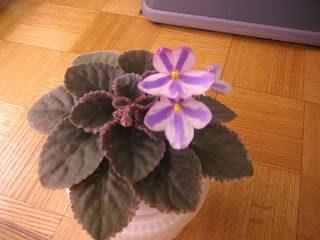



When I first started growing african violets I put down every leaf that was given to me. I couldn't throw a single one out. I was taught to cut the petiole of the leaf to 1" and do it on an angle facing me so that when planted the tiny leaves would grow up in front of the mother leaf as opposed to growing behind it. First, I wash the leaf in a solution of mild dish soap (Ivory) and luke warm water. Then, cut the leaf on an angle and insert it into a solo cup filled 3/4 full of regular african violet soil. Next, I water the leaf with a plain water with 10 drops of superthrive per gallon. Finally, the leaf is placed in an individual plastic sandwich bag and placed under lights. Within 8 weeks tiny mouse ears will appear and when the leaves are about the size of a dime the plantlets are ready to be potted into their own pots (Topic for another post). I must mention that when putting down a leaf you must write down the name of the variety and the date it was put down on the plastic pot. Usually, I write down the variety's name, classification (semi, standard, etc) and the date planted. Now, just sit back and wait.
Like any grower I have experimented with different methods of propagation. As opposed to rooting the leaves in their own solo cups, sometimes I root the leaves right in plastic sandwich bags with a few scoops of soil. It requires one less step and proves to be fruitful. You can use a clothespin and hang the bags from your lip stand or simply lay the bags in the tray. I have also the small black portion cups that you get carry out sauces from restaurants in. They are very shallow and work well for semi, mini, and trailer leaves.
Let me also mention that people prefer to root their leaves in water and once the roots form, transplant them into soil. Personally, I feel that this method adds an unnecessary step to the process but for those like Andrea Worrell it has proven to be the best method for them. It must work because her plants are all perfection!
I have attached a few phots below showing leaves rooting in solo cups, plastic bags, and the portion cups. Make sure and experiment and see which method yields babies the fastest!!!






























